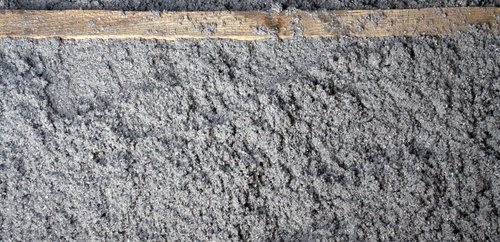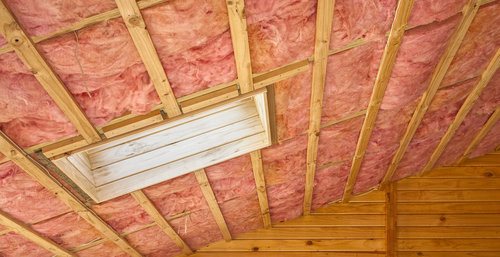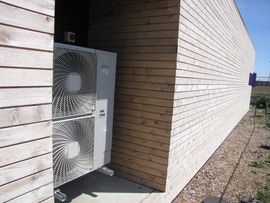Cellulose vs Fiberglass Insulation
Cellulose Insulation
$650 - $670
(240 sq. ft. blown-in, 6 inches of insulation)
VS
Fiberglass Insulation
$310 - $340
(240 sq. ft. batts, 6 inches of insulation)
Cost varies greatly by region (and even by zip code).
To get free estimates from local contractors, please indicate yours.
Cellulose Insulation

- Fills cavities well
- Can be loose or dense as needed
- Environmentally friendly
- Does not degrade
- Does not lose R-value in extreme cold
- No health concerns
- May be flammable
- Not moisture-resistant
- Not an air barrier
- One installation style
(240 sq. ft. blown-in, 6 inches of insulation)
Get free advice and estimates from insulation contractors in your city.
Fiberglass Insulation

- Different insulation styles available
- Easy installation for DIY
- Non-flammable
- Does not promote mildew or mold growth
- May lose R-value in extreme cold
- May lose R-value if compressed
- Batts may not offer as many insulating properties
- Not moisture-resistant
- Not an air barrier
- May be a health concern for installers
(240 sq. ft. batts, 6 inches of insulation)
Get free advice and estimates from insulation contractors in your city.
When it comes to insulating your home, there are two commonly used materials to do the job, fiberglass 1 and cellulose. Of the two, fiberglass 1 is more commonly used, but cellulose has been gaining a lot of traction in recent years as people strive to lower their energy bills.
Both materials improve the energy efficiency of your home but do so in different ways. We outline the differences between them below so that you can make a more informed decision for your home.
R-Value
Whenever you purchase insulation for your home, you will notice that it has something called an R-value. R-values refer to how well an insulation performs at blocking thermal transfer. The higher the R-value, the better the insulation performs.
Fiberglass and cellulose have similar R-values, with ranges depending on how and where they are installed. When installed properly in similar areas, they perform about the same at 3.5 to 3.7 R-value.
Because fiberglass comes in batts or blown-in insulation and both materials can be loosely or densely installed, this can change the ultimate R-value you receive. In some extreme climates, you may also find that the R-value of fiberglass diminishes when it is exposed to extreme cold. If either of the products settles, which is more common with cellulose than with fiberglass, you will also notice a reduction in R-value.
Air Leakage
Neither type of insulation acts as an air barrier. Air circulates through the insulation, and in the case of fiberglass, this is actually part of its insulating properties. The air trapped in the pockets of the insulation is part of what insulates your home.
Cellulose can slow down air flow, particularly in walls. When used in an attic space, however, both types of insulation are ineffective at air flow across the attic floor, such as a strong gust of wind.
If fiberglass batts become compressed, losing some of their air pockets, then this insulation may be more affected by air flow than cellulose, which performs well regardless of density.
Installation
Fiberglass insulation comes in two forms, batts and blown-in. Of the two, batts are easier to install and are frequently put in DIY by homeowners. However, there is a lot of error in installing fiberglass batts, which must be cut around outlets, wires, and pipes. If gaps are left, this can reduce its effectiveness. Fiberglass blown-in involves using a machine to pump 2 the loose insulation into the wall cavities. This is slightly more difficult but provides better installation. It can still be done DIY by renting a machine.
Cellulose insulation is always blown-in. This makes it slightly more difficult than fiberglass batts but comparable to blown-in cellulose. It is commonly installed by a professional but may be installed DIY as well.
Costs
When comparing blown-in insulation, both fiberglass and cellulose are nearly identical in price, both costing around $0.70 to $0.80 per square foot for 6 inches of insulation. Fiberglass batts, however, are less expensive, costing on average $0.30 to $0.40 a square foot for 6 inches of insulation.
Installation costs for blown-in insulation costs around $2 a square foot, where installation costs for batts is around $1 a square foot.
So, for an average installation of a single room of 240 square feet, blown-in insulation of either fiberglass or cellulose will cost between $650 and $670, while the same space insulated using fiberglass batts will cost between $310 and $340.
Flammability
Fiberglass is considered a non-flammable insulation because it is made of very small fibers or shards of glass. This glass can melt, however, in extreme heat caused by a fire. The brown craft paper that backs the batts may catch fire, but blown-in fiberglass is completely non-flammable.
Cellulose insulation is made from paper, sometimes recycled newspaper. This paper is treated to help it become flame-retardant. However, there are some reports of it catching fire around recessed lighting and in extreme heat.
Health Issues
In 1994, fiberglass was classified as a potential carcinogen, a cancer-causing material. However, at the same time, it was declared not to be a health risk to homeowners who have it in their homes.
This is because the small glass fibers that make up the insulation may become airborne if they are disturbed, typically during installation. While they are airborne, they may be inhaled, which over time may cause some types of lung cancer.
Proper installation using masks can protect the installer. Once the material is installed and sealed inside walls, it poses no harm to the occupants of the home.
Cellulose insulation, being made of paper, does not pose any health issues to the installer or home occupants.
Durability
Cellulose is treated to help prevent rot, decay, and mildew but may still develop these issues if there is prolonged contact with moisture.
Fiberglass does not rot, decay, or promote mildew growth, but it may lose some of its R-value over time if it becomes compressed. Excessive moisture may cause it to compress and lose some of its air pockets, which in turn makes it less effective over time.
Environmental Concerns
Cellulose insulation is considered a greener material than fiberglass. It is made from paper that has a minimum of 85% recycled content, such as newspaper. It does not pollute the air during manufacture or use as much energy to produce as fiberglass.
Fiberglass fibers may become airborne, which can be considered a pollutant. And while fiberglass uses some recycled content, it is often closer to 50%, much less than cellulose. It also takes more energy to produce.
Extreme temperatures
While cellulose and fiberglass react similarly under moderate temperature fluctuations, they differ dramatically when the temperature drops significantly. Once the temperature outside falls to well below freezing, around 20º F or below, fiberglass loses as much as 50% of its R-value. This is due to the extreme difference in temperature between the interior of the house and the exterior, and the way that fiberglass insulates, which is by creating a small air pocket.
Cellulose insulation does not break down or lose its R-value in extreme cold, which makes it a better insulation in cold climate areas.
Remodeling Terms Cheat Sheet
Definitions in laymen's terms, cost considerations, pictures and things you need to know.See full cheat sheet.
 1 Fiberglass: Plastic that is reinforced with glass fibers. The fibers may be mixed randomly throughout the plastic, or come in the form of a flat sheet, or be woven into a fabric
1 Fiberglass: Plastic that is reinforced with glass fibers. The fibers may be mixed randomly throughout the plastic, or come in the form of a flat sheet, or be woven into a fabric
 2 Pump: A device used to move air, liquid, or gas by mechanical means
2 Pump: A device used to move air, liquid, or gas by mechanical means
How much does it cost in my city?
Cost varies greatly by region (and even by zip code).
To get free estimates from local contractors, please indicate yours.